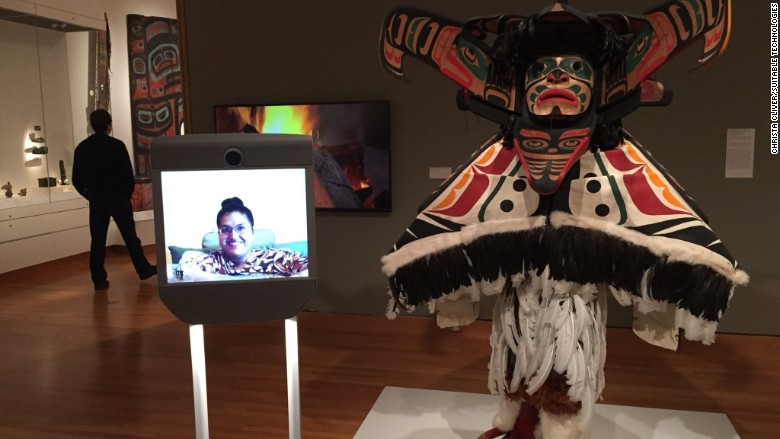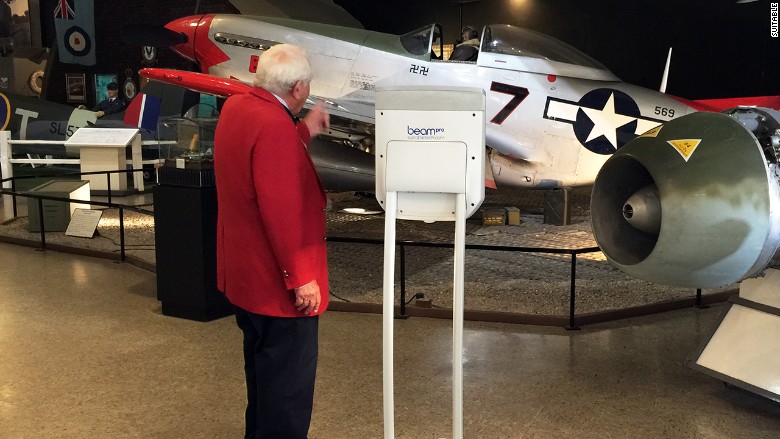
Kavita Krishnaswamy hasn't left her house in six years, but that hasn't stopped her from wandering around the Seattle Art Museum and taking in concerts at the National Music Museum in South Dakota.
A PhD candidate at the University of Maryland, Baltimore County, Krishnaswamy has spinal muscular atrophy and requires assistance 24 hours a day. She was able to make the museum trips using a Beam telepresence robot -- a remotely controlled 16-inch screen mounted five feet above motorized wheels.
Seven museums are taking part in a beta program to test the Beam (owned by Suitable Technologies), including the Detroit Institute of Arts, the Computer History Museum and The Fine Arts Museums of San Francisco. People who are disabled or bedridden can use it to explore museums they might never get to visit in person.
Visitors steer the Beam from their laptop. The Beam's wide-angle camera takes in the scene, and a second camera is pointed at the ground to help with navigation. Six microphones pick up ambient sounds and make it possible to carry on a conversation with people nearby.

Unlike photos, videos or interactive 360-degree images, a Beam gives the user control over where they go and for how long -- and lets them communicate in real time. Instead of looking at images of the historic aircraft on display at San Diego's Air & Space Museum, you can get a personal tour from docent Morton Jorgensen, a former Navy surgeon who worked on Apollo missions.
"I really enjoy the autonomy. It allows me to focus in on the things I want to see," said Krishnaswamy. "And it's not controlled by somebody else. I really like being independent."
Since her first experience using a Beam to attend a computing conference in Seattle, Krishnaswamy says her life has changed drastically. She has more confidence and her calendar is suddenly filled. In a single day this week, she will take part in a debate on her campus, drop in on the Mobile World Congress in Barcelona, and be in Washington D.C. for the Human Robot Interaction conference.
Krishnaswamy has never had the ability to stand. The Beam puts her at eye-level and gives her a new perspective on the world, she says.
Robo-boss: there's no escape from your manager
Museums and tourism are a new market for telepresence robots, which have typically been purchased by companies with remote workers who want to drop in on meetings.
"We were very surprised, but very edified, to discover the community of disabled people, for whom the Beam really does offer a window into otherwise inaccessible and unreachable worlds," said Dr. Cleveland Johnson, director of the National Music Museum, which has been testing a Beam since last year. "We think that, with upgrades to the technology, we could operate an ongoing remote-tour schedule for this important niche of visitors."
There are still a number of kinks to work out before the robots become a standard accessibility feature. Many museums are in older buildings made from heavy materials like stone and concrete, which can interfere with the necessary wi-fi signal. At $17,000, the current technology can also be expensive for museums. (The Beams in the test program are on loan.) Then there are security concerns -- an unaccompanied robot could accidentally bump into an exhibit.
"I do hope that we'll get to the point where you go onto a museum's website and there's a Beam option," said Christa Cliver, head of Beam's museum program. The company is working on new features just for museums, such as overlays of maps and invisible fences to protect art.
Exoskeleton allows paraplegics to walk
For the museums, accessibility is just one potential use of the robots. Researchers who want to look at a collection can Beam there from anywhere in the world. Guest curators or experts on a particular artist could dial in and guide special tours. Smithsonian's National Museum of the American Indian wants to use the Beam to bring in elders from the communities depicted in its exhibits to give oral histories.
Krishnaswamy also has big plans for the technology. She hopes the Beam or similar robots can help her visit other countries, understand other cultures and tour national parks like the Grand Canyon. Though she doesn't own her own, she's already used Beams to successfully present her thesis, with the help of her adviser Dr. Tim Oates and cinematographer Vick Krishna. She is even making new friends.
"If I did not have the Beam I would just be trapped at home," said Krishnaswamy. "Now people know me."

